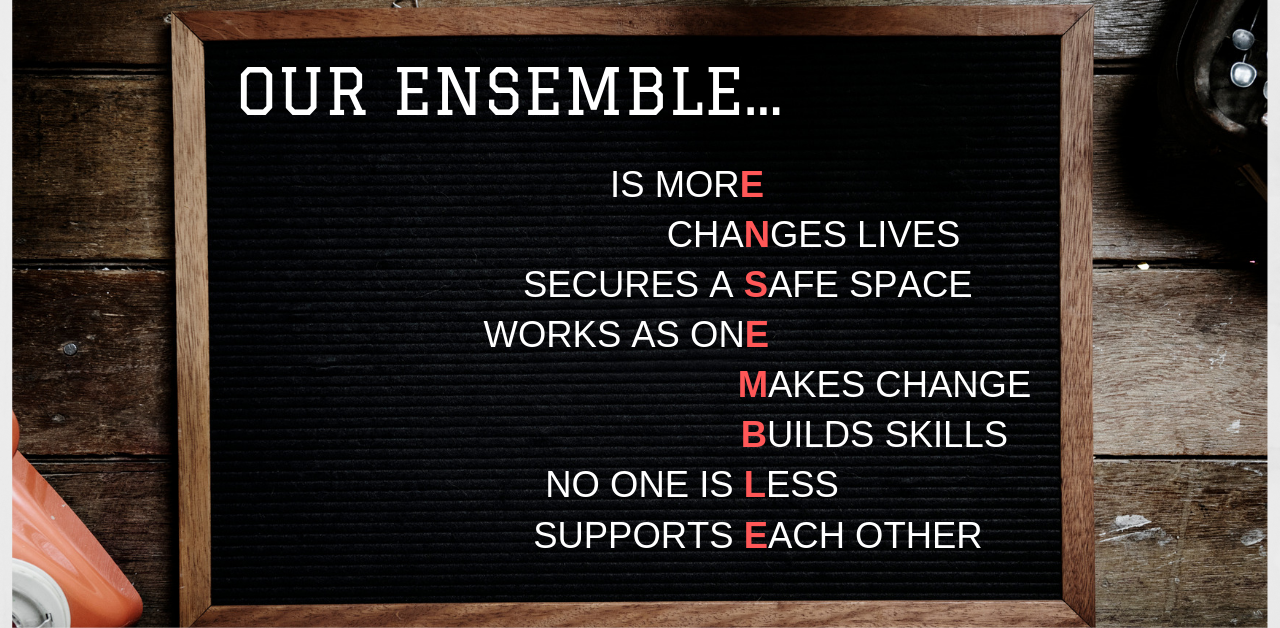Ensembles Are Characters Too!
If you are working on a play or musical with a large ensemble, those actors can sometimes feel “less than” the named characters or the leads. I’m just in the ensemble. I don’t matter. You want to nip those thoughts in the bud. If your actors feel unworthy, that will lead to them giving lackluster performances, or worse, missing rehearsals and eventually dropping out of the production altogether.
Give ensemble actors character development opportunities. Even unnamed ensemble members can be three-dimensional characters that connect with the audience members sitting in the back row of the theatre.
Character Profile
A character profile gives an actor a document to refer to throughout the rehearsal process. It has all the information an actor needs for a character.
Traditionally, the character profile has a page of questions, personality traits, likes, dislikes, and memories. The actor fills it in with information from the script.
However, your ensemble may not even appear in the script. Or perhaps it’s made up of “Townspeople,” “Pirates,” or “Ladies in waiting.” Sometimes there is no information in the script for them to use in their character profile.
That’s perfectly OK. Not only can every member of the ensemble fill out a character profile, it’s going to be easier for them than for the leads.
Why? Because every single character detail comes from an actor’s imagination. They come up with their name, family background, occupation, and where they live. They don’t have to stick with the details the playwright gives them, but can come up with their own details.
There are boundaries, of course. The characters they create have to fit within the world of the play. For example, if you’re playing a Shark in West Side Story, it wouldn’t make sense to have the name Nostradamus and live in a spaceship. But other than that, the sky’s the limit.
Enter, Sit, React
Here’s an exercise that your ensemble can work on by themselves. It also works as a great warm-up. It’s going to help your ensemble establish a physicality for their characters. Often, the ensemble members simply walk, pose, and gesture like themselves. They don’t have a designated character and perhaps the director hasn’t given them the tools to create one. Along with a character profile, you want your ensemble members to think about the physicality of their characters.
Put a chair in an empty space. Have actors enter the space one at a time, as if they are entering a room. They enter, move across the stage, then sit in a chair. Remind them that they have to stay in character while doing each of these actions.
Once they sit, the character realizes they forgot to do something. So they stand and exit.
Each step must be done with a specific physicality. For example, if they are playing an older character, that’s going to affect the way they sit and stand. Students can incorporate the details they come up with in the character profile into this exercise.
Start Here, End There, Carry This
Here’s an exercise that will save you time staging ensemble scenes and help actors keep their character in mind.
Look at a scene in the play you’re working on that requires the ensemble to enter and end up in a certain place (i.e. on a riser or downstage left). You’re going to decide three things:
- Where the ensemble enters from (stage right, right, or audience)
- Where they end up
- What props (if any) they bring with them
This defines where they start, where they end, and what they’re carrying.
Send the ensemble off to another room. They’re going to do an exercise on their own before you see them on stage again. They have the basics – start here, end there, carry this. But what they’re going to do together is share and discuss their moment before as characters. What’s going on in their lives as they come onstage? Where are they coming from? They’re not coming from stage left, right, or the audience. They have to think about their lives in the world of the play. Are they coming from their homes? Are they coming from work? Are they coming from a fight? Are they coming from a date?
Tell the ensemble to pair up or form small groups of 3 or 4. Have them create the story of where they’re coming from, where they’re headed to, why they have those objects, and (most importantly) why they stop onstage at this exact moment. Why here, why now? Have them identify the relationships within their group. Who are they to each other? Remind students they won’t have words to communicate that story to an audience. They’ll have to show the story with action, as they enter and move to their designated spot.
There should never be a movement on stage that isn’t motivated by something. So an actor needs to fill in the details of the basic actions of arriving onstage and stopping. Where are they coming from? Where are they headed to? Why are they stopping here? Who are they with? Every member of your ensemble needs to answer these questions.
Once they’ve answered the questions, have them rough out the staging that gets them to those positions. Have them enter and make their way to their designated spot while “telling” their story without words. Remind students to not forget their physicality. Let them do this on their own and present it to you.
After the students present, you now have something you can shape, as a director. You have a visual story. You’re engaging your actors and encouraging them to make choices that fit within the world of the play. You’re focusing their movements toward the ultimate goal: a stage full of life and story. And furthermore, your ensemble has played an active part in achieving this goal. They weren’t just told to “go downstage and stand there.”



